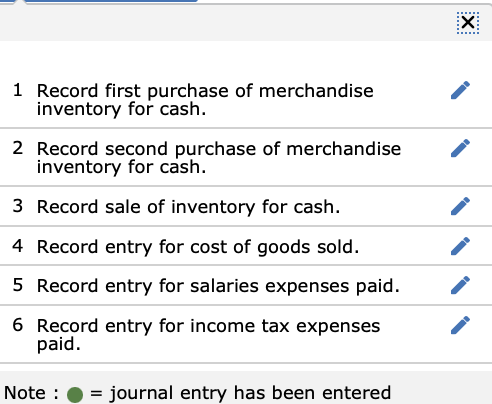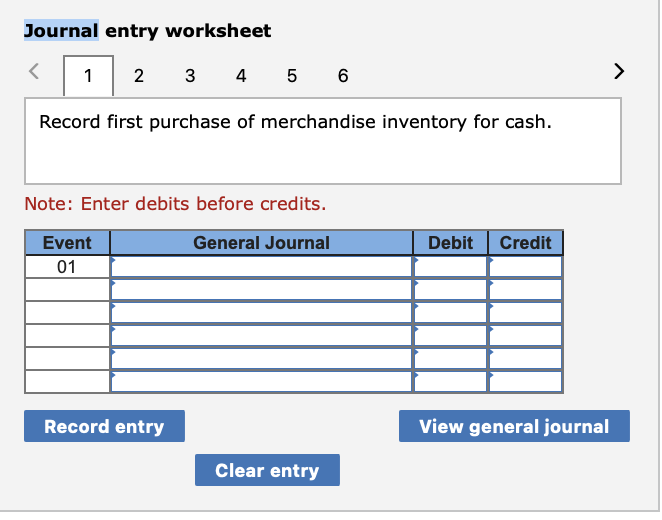Question
The accounting records of Wall's China Shop reflected the following balances as of January 1, Year 2. Cash $ 18,900 Beginning inventory 14,080 (160 units
The accounting records of Wall's China Shop reflected the following balances as of January 1, Year 2.
| Cash | $ 18,900 | |
|---|---|---|
| Beginning inventory | 14,080 | (160 units @ $88) |
| Common stock | 14,400 | |
| Retained earnings | 18,580 |
The following five transactions occurred in Year 2:
- First purchase (cash): 120 units @ $90
- Second purchase (cash): 195 units @ $98
- Sales (all cash): 415 units @ $199
- Paid $14,400 cash for salaries expenses
- Paid cash for income tax at the rate of 40 percent of income before taxes
Required a. Compute the cost of goods sold and ending inventory, assuming (1) FIFO cost flow, (2) LIFO cost flow, and (3) weighted-average cost flow. Compute the income tax expense for each method. b. Record the above transactions in general journal form and post to T-accounts assuming each of the cost flows listed. Assume perpetual inventory system is used. 1. FIFO 2. LIFO 3. Weighted Average c. Use a vertical model to show the Year 2 income statement, balance sheet, and statement of cash flows under FIFO, LIFO, and weighted average.


goes with the attachment under it. need #1-6



goes with the attachment under it.



goes with the attachment under it.


 Compute the cost of goods sold and ending inventory, assuming (1) FIFO cost flow, (2) LIFO cost flow, and (3) weighted-average cost flow. Compute the income tax expense fol each method. (Round intermediate calculations to 3 decimal places. Round your final answers to the nearest whole dollar amount.) 1 Record first purchase of merchandise inventory for cash. 2 Record second purchase of merchandise inventory for cash. 3 Record sale of inventory for cash. 4 Record entry for cost of goods sold. 5 Record entry for salaries expenses paid. 6 Record entry for income tax expenses paid. Journal entry worksheet Note: Enter debits before credits. Record the Year 2 transactions in T-accounts assuming FIFO cost flow. Assume perpetual inv system is used. (Round intermediate calculations to 3 decimal places. Round your final ansh the nearest whole dollar amount.) 1 Record first purchase of merchandise inventory for cash. 2 Record second purchase of merchandise inventory for cash. 3 Record sale of inventory for cash. 4 Record entry for cost of goods sold. 5 Record entry for salaries expenses paid. 6 Record entry for income tax expenses paid. Journal entry worksheet Record first purchase of merchandise inventory for cash. Note: Enter debits before credits. 1 Record first purchase of merchandise inventory for cash. 2 Record second purchase of merchandise inventory for cash. 3 Record sale of inventory for cash. 4 Record entry for cost of goods sold. 5 Record entry for salaries expenses paid. 6 Record entry for income tax expenses paid. Journal entry worksheet Record first purchase of merchandise inventory for cash. Note: Enter debits before credits. Record the Year 2 transactions in T-accounts assuming weighted-average cost flow. Assume perpetual inventory system is used. (Round intermediate calculations to 3 decimal places. Round your final answers to the nearest whole dollar amount.) Show less Use a vertical model to show the Year 2 income statement, balance sheet, and statement of cash flows under FIFO, LIFO, and weighted average. (Round intermediate calculations to 3 decimal places. Round your final answers to the nearest whole dollar amount. Amounts to be deducted and losses should be indicated with a minus sign.) Compute the cost of goods sold and ending inventory, assuming (1) FIFO cost flow, (2) LIFO cost flow, and (3) weighted-average cost flow. Compute the income tax expense fol each method. (Round intermediate calculations to 3 decimal places. Round your final answers to the nearest whole dollar amount.) 1 Record first purchase of merchandise inventory for cash. 2 Record second purchase of merchandise inventory for cash. 3 Record sale of inventory for cash. 4 Record entry for cost of goods sold. 5 Record entry for salaries expenses paid. 6 Record entry for income tax expenses paid. Journal entry worksheet Note: Enter debits before credits. Record the Year 2 transactions in T-accounts assuming FIFO cost flow. Assume perpetual inv system is used. (Round intermediate calculations to 3 decimal places. Round your final ansh the nearest whole dollar amount.) 1 Record first purchase of merchandise inventory for cash. 2 Record second purchase of merchandise inventory for cash. 3 Record sale of inventory for cash. 4 Record entry for cost of goods sold. 5 Record entry for salaries expenses paid. 6 Record entry for income tax expenses paid. Journal entry worksheet Record first purchase of merchandise inventory for cash. Note: Enter debits before credits. 1 Record first purchase of merchandise inventory for cash. 2 Record second purchase of merchandise inventory for cash. 3 Record sale of inventory for cash. 4 Record entry for cost of goods sold. 5 Record entry for salaries expenses paid. 6 Record entry for income tax expenses paid. Journal entry worksheet Record first purchase of merchandise inventory for cash. Note: Enter debits before credits. Record the Year 2 transactions in T-accounts assuming weighted-average cost flow. Assume perpetual inventory system is used. (Round intermediate calculations to 3 decimal places. Round your final answers to the nearest whole dollar amount.) Show less Use a vertical model to show the Year 2 income statement, balance sheet, and statement of cash flows under FIFO, LIFO, and weighted average. (Round intermediate calculations to 3 decimal places. Round your final answers to the nearest whole dollar amount. Amounts to be deducted and losses should be indicated with a minus sign.)
Compute the cost of goods sold and ending inventory, assuming (1) FIFO cost flow, (2) LIFO cost flow, and (3) weighted-average cost flow. Compute the income tax expense fol each method. (Round intermediate calculations to 3 decimal places. Round your final answers to the nearest whole dollar amount.) 1 Record first purchase of merchandise inventory for cash. 2 Record second purchase of merchandise inventory for cash. 3 Record sale of inventory for cash. 4 Record entry for cost of goods sold. 5 Record entry for salaries expenses paid. 6 Record entry for income tax expenses paid. Journal entry worksheet Note: Enter debits before credits. Record the Year 2 transactions in T-accounts assuming FIFO cost flow. Assume perpetual inv system is used. (Round intermediate calculations to 3 decimal places. Round your final ansh the nearest whole dollar amount.) 1 Record first purchase of merchandise inventory for cash. 2 Record second purchase of merchandise inventory for cash. 3 Record sale of inventory for cash. 4 Record entry for cost of goods sold. 5 Record entry for salaries expenses paid. 6 Record entry for income tax expenses paid. Journal entry worksheet Record first purchase of merchandise inventory for cash. Note: Enter debits before credits. 1 Record first purchase of merchandise inventory for cash. 2 Record second purchase of merchandise inventory for cash. 3 Record sale of inventory for cash. 4 Record entry for cost of goods sold. 5 Record entry for salaries expenses paid. 6 Record entry for income tax expenses paid. Journal entry worksheet Record first purchase of merchandise inventory for cash. Note: Enter debits before credits. Record the Year 2 transactions in T-accounts assuming weighted-average cost flow. Assume perpetual inventory system is used. (Round intermediate calculations to 3 decimal places. Round your final answers to the nearest whole dollar amount.) Show less Use a vertical model to show the Year 2 income statement, balance sheet, and statement of cash flows under FIFO, LIFO, and weighted average. (Round intermediate calculations to 3 decimal places. Round your final answers to the nearest whole dollar amount. Amounts to be deducted and losses should be indicated with a minus sign.) Compute the cost of goods sold and ending inventory, assuming (1) FIFO cost flow, (2) LIFO cost flow, and (3) weighted-average cost flow. Compute the income tax expense fol each method. (Round intermediate calculations to 3 decimal places. Round your final answers to the nearest whole dollar amount.) 1 Record first purchase of merchandise inventory for cash. 2 Record second purchase of merchandise inventory for cash. 3 Record sale of inventory for cash. 4 Record entry for cost of goods sold. 5 Record entry for salaries expenses paid. 6 Record entry for income tax expenses paid. Journal entry worksheet Note: Enter debits before credits. Record the Year 2 transactions in T-accounts assuming FIFO cost flow. Assume perpetual inv system is used. (Round intermediate calculations to 3 decimal places. Round your final ansh the nearest whole dollar amount.) 1 Record first purchase of merchandise inventory for cash. 2 Record second purchase of merchandise inventory for cash. 3 Record sale of inventory for cash. 4 Record entry for cost of goods sold. 5 Record entry for salaries expenses paid. 6 Record entry for income tax expenses paid. Journal entry worksheet Record first purchase of merchandise inventory for cash. Note: Enter debits before credits. 1 Record first purchase of merchandise inventory for cash. 2 Record second purchase of merchandise inventory for cash. 3 Record sale of inventory for cash. 4 Record entry for cost of goods sold. 5 Record entry for salaries expenses paid. 6 Record entry for income tax expenses paid. Journal entry worksheet Record first purchase of merchandise inventory for cash. Note: Enter debits before credits. Record the Year 2 transactions in T-accounts assuming weighted-average cost flow. Assume perpetual inventory system is used. (Round intermediate calculations to 3 decimal places. Round your final answers to the nearest whole dollar amount.) Show less Use a vertical model to show the Year 2 income statement, balance sheet, and statement of cash flows under FIFO, LIFO, and weighted average. (Round intermediate calculations to 3 decimal places. Round your final answers to the nearest whole dollar amount. Amounts to be deducted and losses should be indicated with a minus sign.) Step by Step Solution
There are 3 Steps involved in it
Step: 1

Get Instant Access to Expert-Tailored Solutions
See step-by-step solutions with expert insights and AI powered tools for academic success
Step: 2

Step: 3

Ace Your Homework with AI
Get the answers you need in no time with our AI-driven, step-by-step assistance
Get Started


